Perth Station was an ESTRACK Earth station in Australia, located at the Perth International Telecommunications Centre in the suburb of Cullacabardee. It has been retired from service in December, 2015 and has been replaced by the New Norcia Station.
The site has hosted a 15-metre diameter antenna that transmitted in S-band and received in both S- and X-bands.
There were plans to upgrade to X-band transmission in 2004. There was also a GPS Tracking and Data Facility. The site had its own no-break power plant.
The facility was used to routinely communicate with the XMM-Newton spacecraft. It was also used during the Launch and Early Orbit Phase of various satellite launches.

The European Space Operations Centre (ESOC) serves as the main mission control centre for the European Space Agency (ESA) and is located in Darmstadt, Germany. ESOC's primary function is the operation of uncrewed spacecraft on behalf of ESA and the launch and early orbit phases (LEOP) of ESA and third-party missions. The Centre is also responsible for a range of operations-related activities within ESA and in cooperation with ESA's industry and international partners, including ground systems engineering, software development, flight dynamics and navigation, development of mission control tools and techniques and space debris studies.

The Guiana Space Centre, also called Europe's Spaceport, is a spaceport to the northwest of Kourou in French Guiana, a overseas region of France in South America. Kourou is located approximately 500 kilometres north of the equator at a latitude of 5°. In operation since 1968, it is a suitable location for a spaceport because of its near equatorial location and open sea to the east and north.

Esrange Space Center is a rocket range and research centre located about 40 kilometers east of the town of Kiruna in northern Sweden. It is a base for scientific research with high-altitude balloons, investigation of the aurora borealis, sounding rocket launches, and satellite tracking, among other things. Located 200 km north of the Arctic Circle and surrounded by a vast wilderness, its geographic location is ideal for many of these purposes.

New Norcia Station is an ESTRACK Earth station in Australia for communication with spacecraft after launch, in low Earth orbit, in geostationary orbit and in deep space. It is located 10 kilometres (6.2 mi) south of the town of New Norcia, Western Australia. It was the first ESA deep space ground station, followed by Cebreros Station and Malargüe Station.

The European Space Astronomy Centre (ESAC) near Madrid in Spain is the ESA's centre for space science. It hosts the science operation centres for all ESA astronomy and planetary missions together with their scientific archives. Past and present missions represented at ESAC include Akari, BepiColombo, Cassini–Huygens, Cluster, Exomars, Gaia, Herschel Space Observatory, Hubble Space Telescope, ISO, INTEGRAL, IUE, James Webb Space Telescope, LISA Pathfinder, Mars Express, Planck, Rosetta, SOHO, Solar Orbiter, Venus Express, and XMM-Newton.
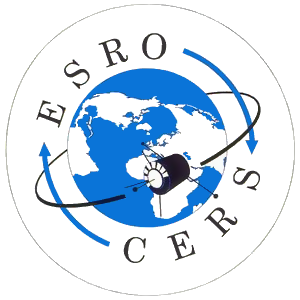
The European Space Research Organisation (ESRO) was an international organisation founded by 10 European nations with the intention of jointly pursuing scientific research in space. It was founded in 1964. As an organisation ESRO was based on a previously existing international scientific institution, CERN. The ESRO convention, the organisations founding document outlines it as an entity exclusively devoted to scientific pursuits. This was the case for most of its lifetime but in the final years before the formation of ESA, the European Space Agency, ESRO began a programme in the field of telecommunications. Consequently, ESA is not a mainly pure science focused entity but concentrates on telecommunications, earth observation and other application motivated activities. ESRO was merged with ELDO in 1975 to form the European Space Agency.

The European Space Research and Technology Centre (ESTEC) is the European Space Agency's main technology development and test centre for spacecraft and space technology. It is situated in Noordwijk, South Holland, in the western Netherlands, although several kilometers off the village but immediately linked to the most Northern district of the nearby town Katwijk.
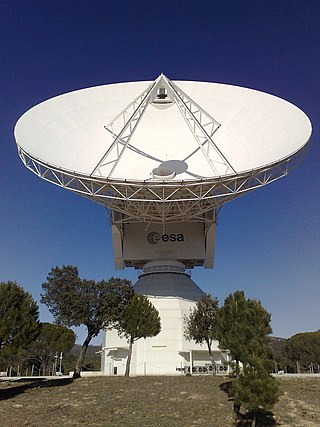
The European Space Tracking (ESTRACK) network consists of a number of ground-based space-tracking stations belonging to the European Space Agency (ESA), and operated by the European Space Operations Centre (ESOC) in Darmstadt, Germany. The stations support various ESA spacecraft and facilitate communications between ground operators and scientific probes such as XMM-Newton, Mars Express, BepiColombo, Gaia. Similar networks are run by the USA, China, Russia, Japan, and India.
Triple M Perth is a commercial radio station owned and operated by Southern Cross Austereo as part of the Triple M network. The station is broadcast to Perth, Western Australia from studios in Subiaco.

96FM is a commercial FM radio station broadcasting in Perth, Western Australia owned by ARN since January 2015. It was formerly part of the Fairfax Media and Village Roadshow networks.
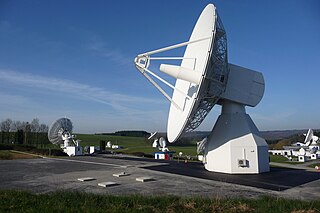
Redu Station is an ESTRACK radio antenna station for communication with spacecraft. The station is located in Wallonia, about one kilometer away from the village of Redu, Belgium. The ground terminals provide tracking capabilities in C band, L-band, S-band, Ku band, and Ka band as well as provide in-orbit tests of telecommunication satellites.

Cebreros Station is a European Space Agency, ESTRACK radio antenna station for communication with spacecraft, located about 10 km east of Cebreros and 90 km from Madrid, Spain, operated by the European Space Operations Centre and INTA. A 35-metre diameter antenna that receives and transmit in X- and Ka-bands is located at the site. Station code is "CEB". 20 kW CW High Power Amplifier (HPA) it was created by Rheinmetall Italia SpA (Italy). The monitoring and control system was implemented by Microsis srl (Italy).

Maspalomas Station is an INTA-operated, ESTRACK radio antenna ground station for communication with spacecraft located at the southern area of Gran Canaria island, on the INTA campus. It is situated on the Montaña Blanca hill and is visible from the coastal resort of Meloneras, close to Maspalomas. It was originally established in the 1960s to support NASA's nascent human spaceflight program.
Kiruna Station is an ESTRACK radio antenna station for communication with spacecraft operated by the Swedish Space Corporation. It is located 38 km east of Kiruna, Sweden. The site hosts one 15 metre- and one 13-metre-diameter antenna, each with S- and X-band reception and S-band transmission. It also hosts a GPS-Tracking and Data Facility (TDF) antenna.
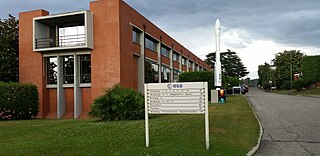
The ESA Centre for Earth Observation is a research centre belonging to the European Space Agency (ESA), located in Frascati (Rome) Italy. It is dedicated to research involving earth observation data taken from satellites, among other specialised activities. The establishment currently hosts the European Space Agency's development team for the Vega launcher.

Malargüe Station is a 35-metre ESTRACK radio antenna in Argentina. It enables the European Space Agency (ESA) to communicate with spacecraft in deep space. It is located 40 kilometres (25 mi) south of the town of Malargüe, Argentina. The Malargüe antenna has two sister stations, Cebreros Station, near Madrid, Spain, and New Norcia Station near New Norcia, Western Australia. The completion of this station allows ESTRACK to track deep space missions continuously.
Kourou Station is an ESTRACK satellite ground station in French Guiana. Two antennas are located at the site: A 15-meter one that receives in X- and S-bands along with smaller 1.3-meter X-band acquisition aid antenna. Additional facilities provide tracking, telemetry, telecommand and radiometric measurements.
Villafranca Station was an ESTRACK satellite ground station in Spain, 30 kilometres (19 mi) north from the city of Madrid in a Villanueva de la Cañada, within the area of European Space Astronomy Centre.
Santa Maria Island Station is an ESTRACK satellite ground station in the Azores, 5 kilometres (3.1 mi) from the town of Vila do Porto on the island of Santa Maria.
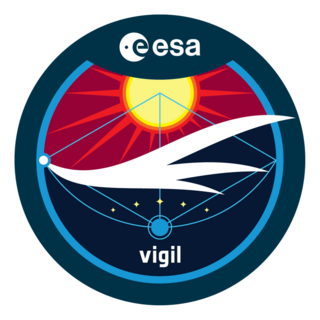
Vigil, formerly known as Lagrange, is a space weather mission developed by the European Space Agency. The mission will provide the ESA Space Weather Office with instruments able to monitor the Sun, its solar corona and interplanetary medium between the Sun and Earth, to provide early warnings of increased solar activity, to identify and mitigate potential threats to society and ground, airborne and space based infrastructure as well as to allow 4 to 5 days space weather forecasts. To this purpose the Vigil mission will place for the first time a spacecraft at Sun-Earth Lagrange point 5 (L5) from where it would get a 'side' view of the Sun, observing regions of solar activity on the solar surface before they turn and face Earth.